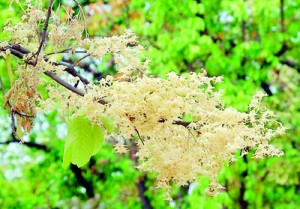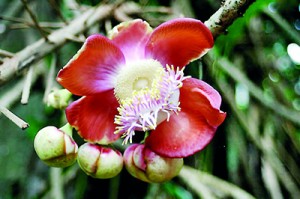Shedding light on Sal trees
You can see it in almost any temple. Its six pastel-pink petals and its strong, almost cloyingly sweet fragrance are unmistakable. It is of course the sal flower, the blossom most favoured by Sinhalese to honour the Buddha with. The sal tree and its flower played a minor but interesting role in the Buddha’s life.

Sal flowers (Shorea robusta)
According to the Mahaparinibbana Sutta, the longest sutta in the Tipitaka, when the Buddha arrived in Kusinara at the end of his final journey, he lay down between two sal trees. Suddenly, unexpectedly and even though it was not the flowering season, these trees burst into blossom and their pollen and petals sprinkled down over the Buddha. Amazed that even Mother Nature herself was paying respects to the Tathagata, Venerable Ananda exclaimed: Lord, the very trees are giving homage to you.” The Buddha replied: “Ananda, these sal trees burst into flower out of season in homage to the Tathagata and covered his body. But the monk or the nun, the lay man or the lay woman who lives practising Dhamma properly and perfectly fulfils the Dhamma, they honour, revere and respect the Tathagata with the highest homage.”
There is little doubt that this association with the Buddha’s parinibbana had helped make the sal flower popular as an offering in Buddhist pujas. The sal tree also serves as a prop for several Jataka stories. The Rukkhadhamma Jataka for example, uses the thickness of a sal forest to illustrate the advantages of unity. In this story, King Vessavana asked all the tree spirits to select for themselves a plant as their home. The Bodhisatta, who had been reborn as a tree spirit, advised his kinsmen to avoid trees that stood alone and pick those that grew close to others. Some did as he advised, making their homes in a thick sal forest, but others moved into isolated trees growing near towns and villages thinking that they would receive offerings humans made to such trees. One day a furious storm swept over the country uprooting even the mightiest and most deeply rooted trees growing in the open. But the sal trees in the forest, supported by each other and with their branches interlaced, withstood the storm.
But there is a fact about what in Sri Lanka is called the sal tree which may come as a surprise to most people. The botanical name for this tree is Eugenia jambolana (Lam), it is called cannonball tree in English, and it is native to the coastal regions of Guyana and Brazil, not to Sri Lanka or anywhere else in South Asia. So of course the cannonball tree cannot be the sal tree mentioned in the Buddhist scriptures.
How this tree originally got to Sri Lanka is uncertain. Brazil was a Portuguese colony as was Sri Lanka, so it may have been introduced to the island by the Portuguese. On the other hand, the British controlled both Guyana and Sri Lanka so it might have been introduced by them.As the

A cannonball tree flower (Eugenia jambolana)
cannonball tree has no commercial value and the English are great lovers of flowers and gardens,they are a more likely candidate for the tree’s introduction into Sri Lanka.
But how and why did the Sinhalese Buddhists mistake the cannonball tree for the sal tree? Again this is uncertain. But if you gently lift the elongated hood-like stamen of the cannonball tree flower you will see a small creamy-white nodule underneath it which looks remarkably like a tiny stupa. It seems likely that when Sinhala Buddhists first became familiar with the cannonball tree, they made an association between the sal flower and the Buddha’s parinibbana, represented by the stupa, and they assumed that the cannonball tree must be the sal tree.
So if the cannonball tree is not the real sal tree then what is? What is called sala in Pali, sal in Hindiand Shorea robusta (Roth) by botanists, is north India’s most well-known timber tree. Its small yellow flowers have a strong jasmine-like perfume and it has large leaves not unlike those of the teak tree. It can grow to a great size, 45 metres high with a girth of 3.6 metres. Specimens of this size today are rare outside state forests and national parks in India and the lowlands of Nepal. They are usually cut long before they reach their maximum size.
Comparing the sal with the cannonball tree the differences between them become immediately apparent. The former has yellow flowers which grow at the end of the branches, its wood is dense and hard, and it bears small green nuts. The cannonball tree’s flowers are pinkish-red, large and fleshy and grow out of the trunk, its timber is soft and porous and its nuts are large, round and brown, not unlike cannonballs, giving the tree its English name.
Lankan pilgrims visiting India will see the real sal trees in the park around the Parinirvana Temple in Kusinara but they are unlikely to ever see any in Sri Lanka. Being native to sub-tropical northern India they do not grow in tropical Sri Lanka. Of course knowing that the cannonball tree is not the sal tree should not stop Buddhists offering it in temples. In fact, the flower’s beautiful colour, form and fragrance make it particularly worthy of being offered to the “teacher of gods and humans, the Fully Enlightened Buddha.”


